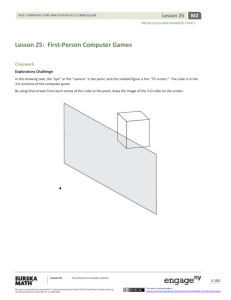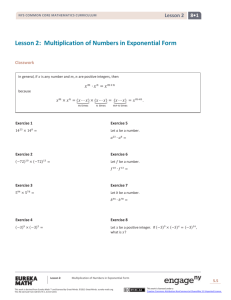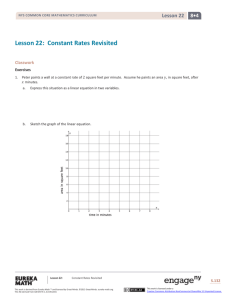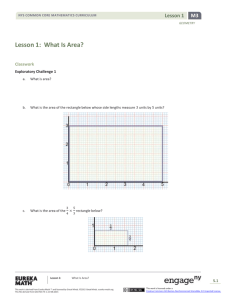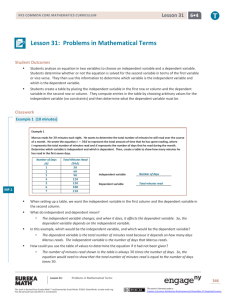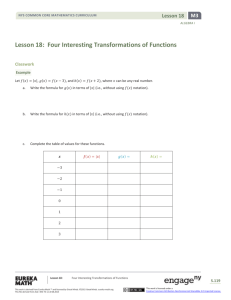Lesson 13 - EngageNY
advertisement
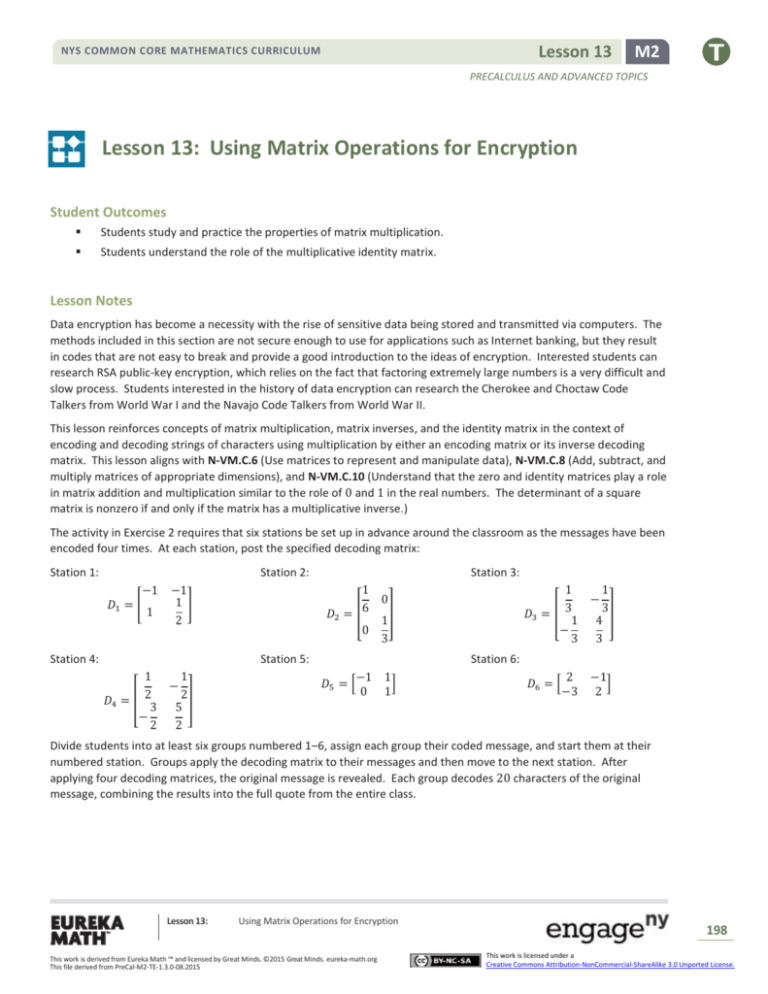
Lesson 13 NYS COMMON CORE MATHEMATICS CURRICULUM M2 PRECALCULUS AND ADVANCED TOPICS Lesson 13: Using Matrix Operations for Encryption Student Outcomes Students study and practice the properties of matrix multiplication. Students understand the role of the multiplicative identity matrix. Lesson Notes Data encryption has become a necessity with the rise of sensitive data being stored and transmitted via computers. The methods included in this section are not secure enough to use for applications such as Internet banking, but they result in codes that are not easy to break and provide a good introduction to the ideas of encryption. Interested students can research RSA public-key encryption, which relies on the fact that factoring extremely large numbers is a very difficult and slow process. Students interested in the history of data encryption can research the Cherokee and Choctaw Code Talkers from World War I and the Navajo Code Talkers from World War II. This lesson reinforces concepts of matrix multiplication, matrix inverses, and the identity matrix in the context of encoding and decoding strings of characters using multiplication by either an encoding matrix or its inverse decoding matrix. This lesson aligns with N-VM.C.6 (Use matrices to represent and manipulate data), N-VM.C.8 (Add, subtract, and multiply matrices of appropriate dimensions), and N-VM.C.10 (Understand that the zero and identity matrices play a role in matrix addition and multiplication similar to the role of 0 and 1 in the real numbers. The determinant of a square matrix is nonzero if and only if the matrix has a multiplicative inverse.) The activity in Exercise 2 requires that six stations be set up in advance around the classroom as the messages have been encoded four times. At each station, post the specified decoding matrix: Station 1: Station 2: −1 𝐷1 = [ 1 −1 1] 2 1 𝐷4 = [ 2 3 − 2 1 − 2] 5 2 Station 4: Station 3: 1 𝐷2 = [6 0 1 𝐷3 = [ 3 1 − 3 0 1 3 ] Station 5: 1 3] 4 3 − Station 6: −1 𝐷5 = [ 0 1 ] 1 𝐷6 = [ 2 −3 −1 ] 2 Divide students into at least six groups numbered 1–6, assign each group their coded message, and start them at their numbered station. Groups apply the decoding matrix to their messages and then move to the next station. After applying four decoding matrices, the original message is revealed. Each group decodes 20 characters of the original message, combining the results into the full quote from the entire class. Lesson 13: Using Matrix Operations for Encryption This work is derived from Eureka Math ™ and licensed by Great Minds. ©2015 Great Minds. eureka-math.org This file derived from PreCal-M2-TE-1.3.0-08.2015 198 This work is licensed under a Creative Commons Attribution-NonCommercial-ShareAlike 3.0 Unported License. Lesson 13 NYS COMMON CORE MATHEMATICS CURRICULUM M2 PRECALCULUS AND ADVANCED TOPICS Classwork Opening (7 minutes) The phrase “The crow flies at midnight” appears to have first occurred in Ian Fleming’s James Bond novel From Russia with Love. It has since become a coded message in spy movies and television shows. Opening A common way to send coded messages is to assign each letter of the alphabet to a number 𝟏–𝟐𝟔 and send the message as a string of integers. For example, if we encode the message “THE CROW FLIES AT MIDNIGHT” according to the chart below, we get the string of numbers 𝟐𝟎, 𝟖, 𝟓, 𝟎, 𝟑, 𝟏𝟖, 𝟏𝟓, 𝟐𝟑, 𝟎, 𝟔, 𝟏𝟐, 𝟗, 𝟓, 𝟏𝟗, 𝟎, 𝟏, 𝟐𝟎, 𝟎, 𝟏𝟑, 𝟗, 𝟒, 𝟏𝟒, 𝟗, 𝟕, 𝟖, 𝟐𝟎. A 𝟏 B 𝟐 C 𝟑 D 𝟒 E 𝟓 F 𝟔 G 𝟕 H 𝟖 I 𝟗 J 𝟏𝟎 K 𝟏𝟏 L 𝟏𝟐 M 𝟏𝟑 N 𝟏𝟒 O 𝟏𝟓 P 𝟏𝟔 Q 𝟏𝟕 R 𝟏𝟖 S 𝟏𝟗 T 𝟐𝟎 U 𝟐𝟏 V 𝟐𝟐 W 𝟐𝟑 X 𝟐𝟒 Y 𝟐𝟓 Z 𝟐𝟔 SPACE 𝟎 However, codes such as these are easily broken using an analysis of the frequency of numbers that appear in the coded messages. We can instead encode a message using matrix multiplication. If a matrix 𝑬 has an inverse, then we can encode a message as follows. First, convert the characters of the message to integers between 𝟏 and 𝟐𝟔 using the chart above. If the encoding matrix 𝑬 is an 𝒏 × 𝒏 matrix, then break up the numerical message into 𝒏 rows of the same length. If needed, add extra zeros to make the rows the same length. Place the rows into a matrix 𝑴. Compute the product 𝑬𝑴 to encode the message. The message is sent as the numbers in the rows of the matrix 𝑬𝑴. Example (10 minutes) A common way to send coded messages is to assign each letter of the alphabet to a number 1–26 and send the message as a string of integers. For example, if we encode the message “THE CROW FLIES AT MIDNIGHT” according to the chart below, we get the string of numbers 20, 8, 5, 0, 3, 18, 15, 23, 0, 6, 12, 9, 5, 19, 0, 1, 20, 0, 13, 9, 4, 14, 9, 7, 8, 20. A 1 B 2 C 3 D 4 E 5 F 6 G 7 H 8 I 9 J 10 K 11 L 12 M 13 N 14 O 15 P 16 Q 17 R 18 S 19 T 20 U 21 V 22 W 23 X 24 Y 25 Z 26 Lesson 13: Using Matrix Operations for Encryption This work is derived from Eureka Math ™ and licensed by Great Minds. ©2015 Great Minds. eureka-math.org This file derived from PreCal-M2-TE-1.3.0-08.2015 SPACE 0 199 This work is licensed under a Creative Commons Attribution-NonCommercial-ShareAlike 3.0 Unported License. Lesson 13 NYS COMMON CORE MATHEMATICS CURRICULUM M2 PRECALCULUS AND ADVANCED TOPICS However, codes such as these are easily broken using an analysis of the frequency of numbers that appear in the coded messages. For example, if the coded phrase is 20, 8, 5, 0, 3, 18, 15, 23, 0, 6, 12, 9, 5, 19, 0, 1, 20, 0, 13, 9, 4, 14, 9, 7, 8, 20, we can see that there are three of the letters assigned to the integer 20, so we may want to try putting a common letter in for the number 20, like S, T, or E. If we assume the word the is used to start the phrase since we have three letters and then a space, that would lead us to think that maybe the number 5 is E, and so on. We can instead encode a message using matrix multiplication. If a matrix 𝐸 has an inverse, then we can encode a message as follows. First, convert the characters of the message to integers between 1 and 26 using the chart above. If the encoding matrix 𝐸 is an 𝑛 × 𝑛 matrix, then break up the numerical message into 𝑛 rows of the same length. If needed, add extra zeros to make the rows the same length. For example, if we want to use an encoding matrix that is 2 × 2, we would write the message in two rows of equal length, filling in zero for the last number if the number of letters was odd. If the encoding matrix is 3 × 3, the message would be written in three equal rows, adding zeros as necessary. Place the rows into a matrix 𝑀. Compute the product 𝐸𝑀 to encode the message. The message is sent as the numbers in the rows of the matrix 𝐸𝑀. 2 1 Using the matrix 𝐸 = [ ], we encode our message as follows: 3 1 Scaffolding: Students who are struggling can be given a simpler phrase such as “Be Happy” or “Dream Big.” Have advanced learners find their own phrase of 30 characters or more and encode using a 3 × 3 matrix. 4, 14, 9, 7, 8, 20. Since 𝐸 is a 2 × 2 matrix, we need to break up our message into two rows. 20, 8, 5, 0, 3, 18, 15, 23, 0, 6, 12, 9, 5, 19, 0, 1, 20, 0, 13, 9, 4, 14, 9, 7, 8, 20 Then, we place the rows into a matrix 𝑀. 20 𝑀=[ 19 MP.2 5 1 0 20 3 0 18 13 15 9 23 4 0 14 6 9 12 7 9 8 5 ] 20 Explain how matrix 𝑀 represents “THE CROW FLIES AT MIDNIGHT.” 8 0 Each letter and space in the phrase was assigned an integer value, and these numbers represent the letters in the phrase. We encode the message into matrix 𝐶 by multiplying 𝐸 ⋅ 𝑀. 2 1 20 8 5 0 3 18 15 23 0 6 12 9 5 ][ ] 3 1 19 0 1 20 0 13 9 4 14 9 7 8 20 59 16 11 20 6 49 39 50 14 21 31 26 30 𝐶=[ ] 79 24 16 20 9 67 54 73 14 27 43 35 35 𝐶 =𝐸⋅𝑀 =[ Thus, the coded message that we send is 59, 16, 11, 20, 6, 49, 39, 50, 14, 21, 31, 26, 30, 79, 24, 16, 20, 9, 67, 54, 73, 14, 27, 43, 35, 35. If this coded message is intercepted, then it cannot easily be decoded unless the recipient knows how it was originally encoded. Be sure to work through this discussion, and emphasize that the way to decode a message is to multiply by the inverse of the encoding message. Lesson 13: Using Matrix Operations for Encryption This work is derived from Eureka Math ™ and licensed by Great Minds. ©2015 Great Minds. eureka-math.org This file derived from PreCal-M2-TE-1.3.0-08.2015 200 This work is licensed under a Creative Commons Attribution-NonCommercial-ShareAlike 3.0 Unported License. Lesson 13 NYS COMMON CORE MATHEMATICS CURRICULUM M2 PRECALCULUS AND ADVANCED TOPICS MP.4 Using what you know about how the message was encoded, as well as matrix multiplication, describe how you would decode this message. How can we find that matrix? The decoding matrix is the inverse of the encoding matrix, so 𝐷 = 𝐸 −1 . What is the decoding matrix? 1 2 1 −1 1 −1 −1 1 ] = [ ]=[ ] 2−3 −3 3 1 2 3 −2 Decode this message! −1 1 59 16 11 20 6 49 39 50 14 21 31 26 30 𝐷⋅𝐶 =[ ][ ] 3 −2 79 24 16 20 9 67 54 73 14 27 43 35 35 20 8 5 0 3 18 15 23 0 6 12 9 5 =[ ] 19 0 1 20 0 13 9 4 14 9 7 8 20 As expected, this is the matrix 𝑀 that stored our original message “THE CROW FLIES AT MIDNIGHT.” We need to know a decoding matrix 𝐷. 𝐷 = 𝐸 −1 = [ Why does this process work? The coded message stored in matrix 𝐶 is the product of matrices 𝐸 and 𝑀, so 𝐶 = 𝐸 ⋅ 𝑀. We then decode the message stored in matrix 𝐶 by multiplying by matrix 𝐷. Since matrices 𝐷 and 𝐸 are inverses, we have 𝐷 ⋅ (𝐸 ⋅ 𝑀) = (𝐷 ⋅ 𝐸) ⋅ 𝑀 = 𝐼 ⋅ 𝑀 = 𝑀. So, encoding and then decoding returns the original message in matrix 𝑀. Explain to your neighbor what you learned about how to encode and decode messages. Teachers should use this as an informal way to check for understanding. Exercise 1 (7 minutes) The encoded phrase in this exercise is “ARCHIMEDES.” Archimedes (c. 287–212 B.C.E., Greece) is regarded as the greatest mathematician of his age and one of the greatest of all time. He developed and applied an early form of integral calculus to derive correct formulas for the area of a circle, volume of a sphere, and area under a parabola. He also found accurate approximations of irrational numbers such as √3 and 𝜋. However, during his lifetime he was known more for his inventions such as the Archimedean screw, compound pulleys, and weapons such as the Claw of Archimedes used to protect Syracuse in times of war. 1 18 3 8 The original message is stored in matrix 𝑀 = [9 13 5 4], and the matrix used to encode the message is 5 19 0 0 1 2 3 𝐸 = [0 2 1]. This exercise introduces students to using a larger matrix to perform the encoding and decoding and 1 1 1 requires that students practice matrix multiplication with non-integer matrix entries. Additionally, because students have not learned a method for finding the inverse of a 3 × 3 matrix, they must demonstrate understanding of the meaning of a matrix inverse in order to decode this matrix. Lesson 13: Using Matrix Operations for Encryption This work is derived from Eureka Math ™ and licensed by Great Minds. ©2015 Great Minds. eureka-math.org This file derived from PreCal-M2-TE-1.3.0-08.2015 201 This work is licensed under a Creative Commons Attribution-NonCommercial-ShareAlike 3.0 Unported License. Lesson 13 NYS COMMON CORE MATHEMATICS CURRICULUM M2 PRECALCULUS AND ADVANCED TOPICS Exercises 1. You have received an encoded message: 𝟑𝟒, 𝟏𝟎𝟏, 𝟏𝟑, 𝟏𝟔, 𝟐𝟑, 𝟒𝟓, 𝟏𝟎, 𝟖, 𝟏𝟓, 𝟓𝟎, 𝟖, 𝟏𝟐. 𝟏 𝟐 𝟑 You know that the message was encoded using matrix 𝑬 = [𝟎 𝟐 𝟏]. 𝟏 𝟏 𝟏 a. Store your message in a matrix 𝑪. What are the dimensions of 𝑪? There are 𝟏𝟐 numbers in the coded message, and it was encoded using a 𝟑 × 𝟑 matrix. Thus, the matrix 𝑪 needs to have three rows. That means 𝑪 has four columns, so 𝑪 is a 𝟑 × 𝟒 matrix. b. You have forgotten whether the proper decoding matrix is matrix 𝑿, 𝒀, or 𝒁 as shown below. Determine which of these is the correct matrix to use to decode this message. 𝟏 𝟏 𝟒 𝟏 𝟏 𝟒 𝟏 𝟏 𝟒 − − − − − − 𝟑 𝟑 𝟑 𝟑 𝟑 𝟑 𝟑 𝟑 𝟑 𝟏 𝟐 𝟏 𝟏 𝟐 𝟏 𝟏 𝟐 𝟏 𝑿= − ,𝒀= − − ,𝒁= − 𝟑 𝟑 𝟑 𝟑 𝟑 𝟑 𝟑 𝟑 𝟑 𝟐 𝟏 𝟐 𝟐 𝟏 𝟐 𝟐 𝟏 𝟐 [− 𝟑 𝟑 − 𝟑] [ 𝟑 −𝟑 𝟑 ] [ 𝟑 − 𝟑 − 𝟑] Scaffolding: Students may need to be reminded that the matrices used to encode and decode a message are inverses. Students may also need to be reminded of the property that defines inverse matrices: 𝐴 and 𝐵 are inverse matrices if 𝐴 ⋅ 𝐵 = 𝐼. Matrices used to encode and decode messages must be inverses of each other. Thus, the correct decoding matrix is the matrix 𝑫 so that 𝑫 ⋅ 𝑬 = 𝑰. We can find the correct decoding matrix by multiplying 𝑿 ⋅ 𝑬, 𝒀 ⋅ 𝑬, and 𝒁 ⋅ 𝑬. 𝟏 𝟑 𝟏 𝑿⋅𝑬 = − 𝟑 𝟐 [− 𝟑 𝟏 − 𝟑 𝟏 𝒀⋅𝑬 = − 𝟑 𝟐 [ 𝟑 𝟏 − 𝟑 𝟏 𝒁⋅𝑬 = − 𝟑 𝟐 [ 𝟑 − 𝟏 𝟒 𝟏 𝟎 𝟎 𝟑 𝟑 𝟏 𝟐 𝟑 𝟐 𝟏 𝟎 𝟏 𝟎 ⋅ [𝟎 𝟐 𝟏] = [ 𝟒 𝟒 𝟕] 𝟑 𝟑 − − − 𝟏 𝟏 𝟏 𝟏 𝟐 𝟑 𝟑 𝟑 − ] 𝟑 𝟑 𝟏 𝟒 𝟏 𝟎 𝟎 − 𝟑 𝟑 𝟐 𝟏 𝟐 𝟐 𝟏 𝟏 𝟐 𝟑 − − 𝟑 𝟑 𝟑 − ⋅ [𝟎 𝟐 𝟏] = 𝟑 𝟑 𝟏 𝟏 𝟏 𝟒 𝟒 𝟕 𝟏 𝟐 [ 𝟑 𝟑 𝟑 ] − 𝟑 𝟑 ] 𝟏 𝟒 − 𝟑 𝟑 𝟏 𝟐 𝟑 𝟏 𝟎 𝟎 𝟐 𝟏 ⋅ [𝟎 𝟐 𝟏] = [𝟎 𝟏 𝟎] 𝟑 𝟑 𝟎 𝟎 𝟏 𝟏 𝟏 𝟏 𝟏 𝟐 − − ] 𝟑 𝟑 − Since 𝒁 ⋅ 𝑬 = 𝑰, we know that 𝒁 is the decoding matrix we need. Lesson 13: Using Matrix Operations for Encryption This work is derived from Eureka Math ™ and licensed by Great Minds. ©2015 Great Minds. eureka-math.org This file derived from PreCal-M2-TE-1.3.0-08.2015 202 This work is licensed under a Creative Commons Attribution-NonCommercial-ShareAlike 3.0 Unported License. Lesson 13 NYS COMMON CORE MATHEMATICS CURRICULUM M2 PRECALCULUS AND ADVANCED TOPICS c. Decode the message. Using matrix 𝒁 to decode, we have 𝟏 𝟏 𝟒 − 𝟑 𝟑 𝟑 𝟑𝟒 𝟏𝟎𝟏 𝟏𝟑 𝟏𝟔 𝟏 𝟐 𝟏 𝑴 =𝒁⋅𝑪 = − ⋅ [𝟐𝟑 𝟒𝟓 𝟏𝟎 𝟖 ] 𝟑 𝟑 𝟑 𝟏𝟓 𝟓𝟎 𝟖 𝟏𝟐 𝟐 𝟏 𝟐 − − [ 𝟑 ] 𝟑 𝟑 𝟑𝟒 𝟐𝟑 𝟔𝟎 𝟏𝟎𝟏 𝟒𝟓 𝟐𝟎𝟎 𝟏𝟑 𝟏𝟎 𝟑𝟐 𝟏𝟔 𝟖 𝟒𝟖 − − + − − + − − + − − + 𝟑 𝟑 𝟑 𝟑 𝟑 𝟑 𝟑 𝟑 𝟑 𝟑 𝟑 𝟑 𝟑𝟒 𝟒𝟔 𝟏𝟓 𝟏𝟎𝟏 𝟗𝟎 𝟓𝟎 𝟏𝟑 𝟐𝟎 𝟖 𝟏𝟔 𝟏𝟔 𝟏𝟐 = − + + − + + − + + − + + 𝟑 𝟑 𝟑 𝟑 𝟑 𝟑 𝟑 𝟑 𝟑 𝟑 𝟑 𝟑 𝟔𝟖 𝟐𝟑 𝟑𝟎 𝟐𝟎𝟐 𝟗𝟎 𝟏𝟎𝟎 𝟐𝟔 𝟏𝟎 𝟏𝟔 𝟑𝟐 𝟖 𝟐𝟒 − − − − − − [ 𝟑 − 𝟑 − 𝟑 𝟑 𝟑 𝟑 𝟑 𝟑 𝟑 𝟑 𝟑 𝟑 ] 𝟏 𝟏𝟖 𝟑 𝟖 = [𝟗 𝟏𝟑 𝟓 𝟒] . 𝟓 𝟒 𝟎 𝟎 − The decoded message is “ARCHIMEDES.” Exercises 2–3 (15 minutes) In this exercise, groups of students decode separate parts of a message that have been encoded four times; as groups complete the decoding of their portion of the message, have them record it in a location that all students can see— either on the white board or projected through a document camera, for example. The decoded messages together spell out a famous quote by Albert Einstein: “Do not worry about your difficulties in mathematics. I can assure you that mine are still greater.” Substitute a different quote if preferred, perhaps a school motto. Carefully encode each of six portions of a quote stored in matrices 𝑀1 to 𝑀6 using encoding matrices 𝐸1 to 𝐸6 as follows. 𝐶1 = 𝐸1 ⋅ 𝐸2 ⋅ 𝐸3 ⋅ 𝐸4 ⋅ 𝑀1 Scaffolding: 𝐶2 = 𝐸2 ⋅ 𝐸3 ⋅ 𝐸4 ⋅ 𝐸5 ⋅ 𝑀2 For struggling students, select a shorter quote, or encode it in fewer than four steps. 𝐶3 = 𝐸3 ⋅ 𝐸4 ⋅ 𝐸5 ⋅ 𝐸6 ⋅ 𝑀3 𝐶4 = 𝐸4 ⋅ 𝐸5 ⋅ 𝐸6 ⋅ 𝐸1 ⋅ 𝑀4 𝐶5 = 𝐸5 ⋅ 𝐸6 ⋅ 𝐸1 ⋅ 𝐸2 ⋅ 𝑀5 𝐶6 = 𝐸6 ⋅ 𝐸1 ⋅ 𝐸2 ⋅ 𝐸3 ⋅ 𝑀6 𝐸1 = [ 1 −2 2 6 ]; 𝐸2 = [ −2 0 0 4 ]; 𝐸3 = [ 3 1 1 5 ]; 𝐸4 = [ 1 3 −1 1 ]; 𝐸5 = [ 0 1 1 2 ]; 𝐸6 = [ 1 3 1 ] 2 Divide the class into at least six groups of two or three students, numbered 1–6, assigning multiple groups to the same number as needed. Set up six stations around the room in a circular arrangement. Have each group start at the station with the same number as the group—Group 1 starts at Station 1, Group 2 starts at Station 2, etc. At each station, the groups apply the posted decoding matrix to their encoded messages shown below, and then they progress to the next station, with groups at Station 6 proceeding to Station 1. It requires four decoding steps with different matrices (such as 𝐷2 , 𝐷3 , 𝐷4 and 𝐷5 ) to uncover a group’s portion of the original message. Lesson 13: Using Matrix Operations for Encryption This work is derived from Eureka Math ™ and licensed by Great Minds. ©2015 Great Minds. eureka-math.org This file derived from PreCal-M2-TE-1.3.0-08.2015 203 This work is licensed under a Creative Commons Attribution-NonCommercial-ShareAlike 3.0 Unported License. Lesson 13 NYS COMMON CORE MATHEMATICS CURRICULUM M2 PRECALCULUS AND ADVANCED TOPICS At each station, post the matrix listed below. Station 1: 𝐷1 = [ −1 Station 2: 𝐷2 = [ −1 1 ] 2 1 1 6 0 0 1 3 1 Station 3: 𝐷3 = [ 31 − 3 1 Station 4: 𝐷4 = [ 23 − 2 −1 Station 5: 𝐷5 = [ 0 2 Station 6: 𝐷6 = [ −3 2. ] 1 3 ] 4 3 − 1 2 ] 5 2 − 1 ] 1 −1 ] 2 You have been assigned a group number. The message your group receives is listed below. This message is TOP SECRET! It is of such importance that it has been encoded four times. Your group’s portion of the coded message is listed below. Group 1: 𝟏𝟓𝟎𝟎, 𝟑𝟖𝟒𝟎, 𝟎, 𝟑𝟒𝟒𝟒, 𝟑𝟒𝟐𝟎, 𝟒𝟑𝟓𝟎, 𝟎, 𝟒𝟖𝟐𝟒, 𝟑𝟔𝟕𝟐, 𝟑𝟒𝟕𝟒, −𝟐𝟓𝟗𝟐, −𝟔𝟔𝟔𝟎, 𝟎, −𝟓𝟗𝟕𝟔, −𝟓𝟗𝟒𝟎, −𝟕𝟓𝟔𝟎, 𝟎, −𝟖𝟑𝟖𝟖, −𝟔𝟑𝟕𝟐, −𝟔𝟎𝟒𝟖 Group 2: 𝟐𝟒𝟐𝟒, 𝟑𝟎𝟐𝟒, −𝟏𝟑𝟖, 𝟑𝟗𝟔, −𝟓𝟓𝟖, −𝟏𝟖𝟗𝟎, −𝟏𝟕𝟓𝟐, 𝟏𝟓𝟏𝟐, −𝟐𝟗𝟒𝟔, 𝟏𝟒𝟓𝟖, 𝟒𝟑𝟖, 𝟓𝟒𝟎, −𝟐𝟒, 𝟕𝟐, −𝟗𝟎, −𝟑𝟐𝟒, −𝟑𝟎𝟎, 𝟐𝟕𝟎, −𝟓𝟏𝟎, 𝟐𝟕𝟎 Group 3: 𝟒𝟖𝟗, 𝟏𝟒𝟐𝟎, 𝟔𝟎𝟔, 𝟑𝟓𝟓, 𝟏𝟏𝟓𝟏, 𝟑𝟑, 𝟏𝟎𝟎𝟐, 𝟖𝟐𝟗, 𝟗𝟗, 𝟏𝟏𝟐𝟏, 𝟏𝟖𝟎, 𝟓𝟐𝟎, 𝟐𝟐𝟐, 𝟏𝟑𝟎, 𝟒𝟐𝟐, 𝟏𝟐, 𝟑𝟔𝟔, 𝟑𝟎𝟒, 𝟑𝟔, 𝟒𝟏𝟎 Group 4: −𝟏𝟖, 𝟏𝟎, −𝟏𝟖, 𝟒𝟒, −𝟓𝟒, 𝟒𝟐, −𝟔, −𝟕𝟒, −𝟗𝟖, −𝟏𝟐𝟒, 𝟎, 𝟏𝟎, −𝟏𝟐, 𝟒𝟔, −𝟐𝟔, 𝟒𝟐, −𝟒, −𝟑𝟔, −𝟔𝟎, −𝟖𝟐 Group 5: −𝟏𝟐𝟎, 𝟎, −𝟕𝟖, −𝟓𝟒, −𝟖𝟒, −𝟑𝟎, 𝟎, −𝟔, −𝟏𝟎𝟖, −𝟑𝟎, −𝟏𝟐𝟎, 𝟏𝟏𝟒, 𝟒𝟐, 𝟎, −𝟏𝟐, 𝟒𝟐, 𝟎, 𝟑𝟔, 𝟎, 𝟎 Group 6: 𝟏𝟐𝟔, 𝟏𝟐𝟎, 𝟔𝟎, 𝟏𝟔𝟐, 𝟖𝟒, 𝟏𝟐𝟎, 𝟏𝟗𝟐, 𝟒𝟐, 𝟖𝟒, 𝟏𝟗𝟐, −𝟏𝟖, −𝟑𝟔𝟎, −𝟗𝟎, −𝟑𝟐𝟒, 𝟎, −𝟏𝟖, −𝟐𝟏𝟔, −𝟑𝟔, −𝟗𝟎, −𝟑𝟐𝟒 a. Store your message in a matrix 𝑪 with two rows. How many columns does matrix 𝑪 have? (Sample responses are provided for Group 1.) Our message is stored in a matrix with ten columns: 𝟏𝟓𝟎𝟎 𝟑𝟖𝟒𝟎 𝟎 𝟑𝟒𝟒𝟒 𝟑𝟒𝟐𝟎 𝟒𝟑𝟓𝟎 𝟎 𝟒𝟖𝟐𝟒 𝟑𝟔𝟕𝟐 𝟑𝟒𝟕𝟒 𝑪=[ ] −𝟐𝟓𝟗𝟐 −𝟔𝟔𝟔𝟎 𝟎 −𝟓𝟗𝟕𝟔 −𝟓𝟗𝟒𝟎 −𝟕𝟓𝟔𝟎 𝟎 −𝟖𝟑𝟖𝟖 −𝟔𝟑𝟕𝟐 −𝟔𝟎𝟒𝟖 Lesson 13: Using Matrix Operations for Encryption This work is derived from Eureka Math ™ and licensed by Great Minds. ©2015 Great Minds. eureka-math.org This file derived from PreCal-M2-TE-1.3.0-08.2015 204 This work is licensed under a Creative Commons Attribution-NonCommercial-ShareAlike 3.0 Unported License. Lesson 13 NYS COMMON CORE MATHEMATICS CURRICULUM M2 PRECALCULUS AND ADVANCED TOPICS b. Begin at the station of your group number, and apply the decoding matrix at this first station. −𝟏 −𝟏 𝟏] 𝟏 𝟐 −𝟏 −𝟏 𝟑𝟖𝟒𝟎 𝟎 𝟑𝟒𝟒𝟒 𝟑𝟒𝟐𝟎 𝟒𝟑𝟓𝟎 𝟎 𝟒𝟖𝟐𝟒 𝟑𝟔𝟕𝟐 𝟑𝟒𝟕𝟒 𝟏 ] ⋅ [ 𝟏𝟓𝟎𝟎 𝑫𝟏 ⋅ 𝑪 = [ ] 𝟏 −𝟐𝟓𝟗𝟐 −𝟔𝟔𝟔𝟎 𝟎 −𝟓𝟗𝟕𝟔 −𝟓𝟗𝟒𝟎 −𝟕𝟓𝟔𝟎 𝟎 −𝟖𝟑𝟖𝟖 −𝟔𝟑𝟕𝟐 −𝟔𝟎𝟒𝟖 𝟐 𝟏𝟎𝟗𝟐 𝟐𝟖𝟐𝟎 𝟎 𝟐𝟓𝟑𝟐 𝟐𝟓𝟐𝟎 𝟑𝟐𝟏𝟎 𝟎 𝟑𝟓𝟔𝟒 𝟐𝟕𝟎𝟎 𝟐𝟓𝟕𝟒 =[ ] 𝟐𝟎𝟒 𝟓𝟏𝟎 𝟎 𝟒𝟓𝟔 𝟒𝟓𝟎 𝟓𝟕𝟎 𝟎 𝟔𝟑𝟎 𝟒𝟖𝟔 𝟒𝟓𝟎 𝑫𝟏 = [ c. Proceed to the next station in numerical order; if you are at Station 6, proceed to Station 1. Apply the decoding matrix at this second station. 𝟏 𝟎 𝑫𝟐 = [𝟔 ] 𝟏 𝟎 𝟑 𝟏 𝟎 𝟏𝟎𝟗𝟐 𝟐𝟖𝟐𝟎 𝟎 𝑫𝟐 ⋅ 𝑫𝟏 ⋅ 𝑪 = [𝟔 ]⋅[ 𝟏 𝟐𝟎𝟒 𝟓𝟏𝟎 𝟎 𝟎 𝟑 𝟏𝟖𝟐 𝟒𝟕𝟎 𝟎 𝟒𝟐𝟐 𝟒𝟐𝟎 =[ 𝟔𝟖 𝟏𝟕𝟎 𝟎 𝟏𝟓𝟐 𝟏𝟓𝟎 d. 𝟏 𝟑] 𝟒 𝟑 𝟏 − 𝟑] ⋅ [𝟏𝟖𝟐 𝟒 𝟔𝟖 𝟑 𝟏𝟎𝟎 𝟎 𝟗𝟎 𝟕𝟎 𝟎 𝟔𝟐 − 𝟒𝟕𝟎 𝟎 𝟒𝟐𝟐 𝟒𝟐𝟎 𝟓𝟑𝟓 𝟎 𝟓𝟗𝟒 𝟒𝟓𝟎 𝟒𝟐𝟗 ] 𝟏𝟕𝟎 𝟎 𝟏𝟓𝟐 𝟏𝟓𝟎 𝟏𝟗𝟎 𝟎 𝟐𝟏𝟎 𝟏𝟔𝟐 𝟏𝟓𝟎 𝟗𝟎 𝟏𝟏𝟓 𝟎 𝟏𝟐𝟖 𝟗𝟔 𝟗𝟑 ] 𝟔𝟎 𝟕𝟓 𝟎 𝟖𝟐 𝟔𝟔 𝟓𝟕 Proceed to the next station in numerical order; if you are at Station 6, proceed to Station 1. Apply the decoding matrix at this fourth station. 𝟏 𝑫𝟒 = [ 𝟐 𝟑 − 𝟐 𝟏 𝑫𝟒 ⋅ 𝑫𝟑 ⋅ 𝑫𝟐 ⋅ 𝑫𝟏 ⋅ 𝑪 = [ 𝟐 𝟑 − 𝟐 𝟒 =[ 𝟏𝟖 f. 𝟓𝟑𝟓 𝟎 𝟓𝟗𝟒 𝟒𝟓𝟎 𝟒𝟐𝟗 ] 𝟏𝟗𝟎 𝟎 𝟐𝟏𝟎 𝟏𝟔𝟐 𝟏𝟓𝟎 Proceed to the next station in numerical order; if you are at Station 6, proceed to Station 1. Apply the decoding matrix at this third station. 𝟏 𝑫𝟑 = [ 𝟑 𝟏 − 𝟑 𝟏 𝑫𝟑 ⋅ 𝑫𝟐 ⋅ 𝑫𝟏 ⋅ 𝑪 = [ 𝟑 𝟏 − 𝟑 𝟑𝟖 =[ 𝟑𝟎 e. 𝟐𝟓𝟑𝟐 𝟐𝟓𝟐𝟎 𝟑𝟐𝟏𝟎 𝟎 𝟑𝟓𝟔𝟒 𝟐𝟕𝟎𝟎 𝟐𝟓𝟕𝟒 ] 𝟒𝟓𝟔 𝟒𝟓𝟎 𝟓𝟕𝟎 𝟎 𝟔𝟑𝟎 𝟒𝟖𝟔 𝟒𝟓𝟎 𝟏 𝟐] 𝟓 𝟐 𝟏 − 𝟐] ⋅ [𝟑𝟖 𝟓 𝟑𝟎 𝟐 𝟏𝟓 𝟎 𝟏𝟒 𝟐𝟓 𝟎 𝟐𝟎 − 𝟏𝟎𝟎 𝟎 𝟗𝟎 𝟗𝟎 𝟏𝟏𝟓 𝟎 𝟏𝟐𝟖 𝟗𝟔 𝟗𝟑 ] 𝟕𝟎 𝟎 𝟔𝟐 𝟔𝟎 𝟕𝟓 𝟎 𝟖𝟐 𝟔𝟔 𝟓𝟕 𝟏𝟓 𝟐𝟎 𝟎 𝟐𝟑 𝟏𝟓 𝟏𝟖 ] 𝟏𝟓 𝟏𝟓 𝟎 𝟏𝟑 𝟐𝟏 𝟑 If we know the original message had 𝟐𝟏 characters and the last letter was an H, decode your message. The numerical message is 𝟒, 𝟏𝟓, 𝟎, 𝟏𝟒, 𝟏𝟓, 𝟐𝟎, 𝟎, 𝟐𝟑, 𝟏𝟓, 𝟏𝟖, 𝟏𝟖, 𝟐𝟓, 𝟎, 𝟐𝟎, 𝟏𝟓, 𝟏𝟓, 𝟎, 𝟏𝟑, 𝟐𝟏, 𝟑, which represents the characters “DO NOT WORRY TOO MUCH.” Lesson 13: Using Matrix Operations for Encryption This work is derived from Eureka Math ™ and licensed by Great Minds. ©2015 Great Minds. eureka-math.org This file derived from PreCal-M2-TE-1.3.0-08.2015 205 This work is licensed under a Creative Commons Attribution-NonCommercial-ShareAlike 3.0 Unported License. Lesson 13 NYS COMMON CORE MATHEMATICS CURRICULUM M2 PRECALCULUS AND ADVANCED TOPICS 3. Sydnie was in Group 1 and tried to decode her message by calculating the matrix (𝑫𝟏 ⋅ 𝑫𝟐 ⋅ 𝑫𝟑 ⋅ 𝑫𝟒 ) and then multiplying (𝑫𝟏 ⋅ 𝑫𝟐 ⋅ 𝑫𝟑 ⋅ 𝑫𝟒 ) ⋅ 𝑪. This produced the matrix 𝟏𝟎𝟓𝟐𝟔 𝑴=[ 𝟑 a. 𝟐𝟕𝟎𝟐𝟎 𝟑 𝟑𝟎𝟔𝟓𝟓 𝟎 𝟏𝟏𝟑𝟑𝟔 𝟖𝟔𝟏𝟔 𝟖𝟏𝟕𝟏 𝟑 ]. 𝟖𝟒𝟕𝟓 𝟔𝟏𝟕𝟕 −𝟏𝟒𝟓𝟓 −𝟑𝟕𝟑𝟓 𝟎 −𝟑𝟑𝟓𝟏 −𝟑𝟑𝟑𝟎 − 𝟎 −𝟒𝟕𝟎𝟏 −𝟑𝟓𝟕𝟑 − 𝟐 𝟐 How did she know that she made a mistake? 𝟎 𝟐𝟒𝟐𝟒𝟐 𝟑 𝟖𝟎𝟑𝟎 If Sydnie had properly decoded her message, all entries in the matrix 𝑴 would be integers between 𝟎 and 𝟐𝟔. b. Matrix 𝑪 was encoded using matrices 𝑬𝟏 , 𝑬𝟐 , 𝑬𝟑 , and 𝑬𝟒 , where 𝑫𝟏 decodes a message encoded by 𝑬𝟏 , 𝑫𝟐 decodes a message encoded by 𝑬𝟐 , and so on. What is the relationship between matrices 𝑬𝟏 and 𝑫𝟏 , between 𝑬𝟐 and 𝑫𝟐 , etc.? Matrices 𝑬𝟏 and 𝑫𝟏 are inverse matrices, as are 𝑬𝟐 and 𝑫𝟐 , 𝑬𝟑 , and 𝑫𝟑 , and so on. c. The matrix that Sydnie received was encoded by 𝑪 = 𝑬𝟏 ⋅ 𝑬𝟐 ⋅ 𝑬𝟑 ⋅ 𝑬𝟒 ⋅ 𝑴. Explain to Sydnie how the decoding process works to recover the original matrix 𝑴, and devise a correct method for decoding using multiplication by a single decoding matrix. Since 𝑪 = 𝑬𝟏 ⋅ 𝑬𝟐 ⋅ 𝑬𝟑 ⋅ 𝑬𝟒 ⋅ 𝑴, we can recover the original matrix 𝑴 by multiplying both sides of this equation by the proper decoding matrix at each step, remembering that 𝑫𝟏 ⋅ 𝑬𝟏 = 𝑰, 𝑫𝟐 ⋅ 𝑬𝟐 = 𝑰, etc. 𝑪 = 𝑬𝟏 ⋅ 𝑬𝟐 ⋅ 𝑬𝟑 ⋅ 𝑬𝟒 ⋅ 𝑴 𝑫𝟏 ⋅ 𝑪 = 𝑫𝟏 ⋅ (𝑬𝟏 ⋅ 𝑬𝟐 ⋅ 𝑬𝟑 ⋅ 𝑬𝟒 ⋅ 𝑴) = (𝑫𝟏 ⋅ 𝑬𝟏 ) ⋅ (𝑬𝟐 ⋅ 𝑬𝟑 ⋅ 𝑬𝟒 ⋅ 𝑴) = 𝑰 ⋅ (𝑬𝟐 ⋅ 𝑬𝟑 ⋅ 𝑬𝟒 ⋅ 𝑴) = (𝑬𝟐 ⋅ 𝑬𝟑 ⋅ 𝑬𝟒 ⋅ 𝑴) 𝑫𝟐 ⋅ 𝑫𝟏 ⋅ 𝑪 = 𝑫𝟐 ⋅ (𝑬𝟐 ⋅ 𝑬𝟑 ⋅ 𝑬𝟒 ⋅ 𝑴) = (𝑫𝟐 ⋅ 𝑬𝟐 ) ⋅ (𝑬𝟑 ⋅ 𝑬𝟒 ⋅ 𝑴) = 𝑰 ⋅ (𝑬𝟑 ⋅ 𝑬𝟒 ⋅ 𝑴) = (𝑬𝟑 ⋅ 𝑬𝟒 ⋅ 𝑴) 𝑫𝟑 ⋅ 𝑫𝟐 ⋅ 𝑫𝟏 ⋅ 𝑪 = 𝑫𝟑 ⋅ (𝑬𝟑 ⋅ 𝑬𝟒 ⋅ 𝑴) = (𝑫𝟑 ⋅ 𝑬𝟑 ) ⋅ (𝑬𝟒 ⋅ 𝑴) = 𝑰 ⋅ (𝑬𝟒 ⋅ 𝑴) = 𝑬𝟒 ⋅ 𝑴 𝑫𝟒 ⋅ 𝑫𝟑 ⋅ 𝑫𝟐 ⋅ 𝑫𝟏 ⋅ 𝑪 = 𝑫𝟒 ⋅ (𝑬𝟒 ⋅ 𝑴) = (𝑫𝟒 ⋅ 𝑬𝟒 ) ⋅ 𝑴 = 𝑰⋅𝑴 =𝑴 Since matrix multiplication is associative, this means that 𝑴 = (𝑫𝟒 ⋅ 𝑫𝟑 ⋅ 𝑫𝟐 ⋅ 𝑫𝟏 ) ⋅ 𝑪. Lesson 13: Using Matrix Operations for Encryption This work is derived from Eureka Math ™ and licensed by Great Minds. ©2015 Great Minds. eureka-math.org This file derived from PreCal-M2-TE-1.3.0-08.2015 206 This work is licensed under a Creative Commons Attribution-NonCommercial-ShareAlike 3.0 Unported License. Lesson 13 NYS COMMON CORE MATHEMATICS CURRICULUM M2 PRECALCULUS AND ADVANCED TOPICS d. Apply the method you devised in part (c) to your group’s message to verify that it works. 𝟏 𝟏 𝟏 𝟏 𝟏 −𝟏 −𝟏 − − 𝟎 𝟐 𝟐 𝟑 𝟑 𝟏] (𝑫𝟒 ⋅ 𝑫𝟑 ⋅ 𝑫𝟐 ⋅ 𝑫𝟏 ) = [ ]⋅[ ] ⋅ [𝟔 ]⋅[ 𝟏 𝟒 𝟏 𝟑 𝟓 𝟏 𝟐 − 𝟎 − 𝟑 𝟑 𝟑 𝟐 𝟐 𝟏 𝟏 𝟏 𝟕 𝟏 𝟓 − − − − − 𝟔] = [ 𝟑 𝟑𝟔] 𝟔] ⋅ [ 𝟔 =[ 𝟑 𝟏 𝟏 𝟑 𝟑𝟏 𝟒 𝟐𝟑 − 𝟑 𝟔 𝟐 𝟑𝟔 𝟑 𝟔 So, (𝑫𝟒 ⋅ 𝑫𝟑 ⋅ 𝑫𝟐 ⋅ 𝑫𝟏 ) ⋅ 𝑪 𝟏 𝟕 − − 𝟏𝟓𝟎𝟎 𝟑𝟖𝟒𝟎 𝟎 𝟑𝟒𝟒𝟒 𝟑𝟒𝟐𝟎 𝟒𝟑𝟓𝟎 𝟎 𝟒𝟖𝟐𝟒 𝟑𝟔𝟕𝟐 𝟑𝟒𝟕𝟒 𝟑 𝟑𝟔 =[ ]⋅[ ] 𝟑 𝟑𝟏 −𝟐𝟓𝟗𝟐 −𝟔𝟔𝟔𝟎 𝟎 −𝟓𝟗𝟕𝟔 −𝟓𝟗𝟒𝟎 −𝟕𝟓𝟔𝟎 𝟎 −𝟖𝟑𝟖𝟖 −𝟔𝟑𝟕𝟐 −𝟔𝟎𝟒𝟖 𝟐 𝟑𝟔 𝟒 𝟏𝟓 𝟎 𝟏𝟒 𝟏𝟓 𝟐𝟎 𝟎 𝟐𝟑 𝟏𝟓 𝟏𝟖 =[ ] 𝟏𝟖 𝟐𝟓 𝟎 𝟐𝟎 𝟏𝟓 𝟏𝟓 𝟎 𝟏𝟑 𝟐𝟏 𝟑 This is the same decoded message that we found in Exercise 2, part (f). Exercise 4 (Optional, 8 minutes) The encoded phrase in this exercise is “RAMANUJAN.” Srinivasa Ramanujan (1887–1920) was a self-taught mathematician from India who made significant contributions to many branches of mathematics, particularly analysis and number theory, compiling thousands of mathematical results. Although he died young, he is widely considered to be one of the greatest mathematicians of his time. 18 1 13 The original message is stored in matrix 𝑀 = [ 1 14 21], and the matrix used to encode the message is 10 1 14 1 2 1 𝐸 = [−1 0 2 ]. In this optional exercise, students need to reason through the process of encoding and decoding to 1 1 −1 recover a missing entry in the decoding matrix when the encoding matrix is unknown. Use this exercise as an extension for students who have finished the previous exercises quickly. 4. 𝟑𝟎 𝟑𝟎 𝟔𝟗 You received a coded message in the matrix 𝑪 = [ 𝟐 𝟏 𝟏𝟓]. However, the matrix 𝑫 that will decode this 𝟗 𝟏𝟒 𝟐𝟎 message has been corrupted, and you do not know the value of entry 𝒅𝟏𝟐 . You know that all entries in matrix 𝑫 are 𝟐 𝒙 −𝟒 integers. Using 𝒙 to represent this unknown entry, the decoding matrix 𝑫 is given by 𝑫 = [−𝟏 𝟐 𝟑 ]. Decode 𝟏 −𝟏 −𝟐 the message in matrix 𝑪. Decoding the message requires that we multiply 𝑫 ⋅ 𝑪: 𝟐 𝒙 −𝟒 𝟑𝟎 𝟑𝟎 𝟔𝟗 𝑫 ⋅ 𝑪 = [−𝟏 𝟐 𝟑 ]⋅[ 𝟐 𝟏 𝟏𝟓] 𝟗 𝟏𝟒 𝟐𝟎 𝟏 −𝟏 −𝟐 𝟐𝟒 + 𝟐𝒙 𝟒 + 𝒙 𝟓𝟖 + 𝟏𝟓𝒙 =[ 𝟏 𝟏𝟒 𝟐𝟏 ] 𝟏𝟎 𝟏 𝟏𝟒 Lesson 13: Using Matrix Operations for Encryption This work is derived from Eureka Math ™ and licensed by Great Minds. ©2015 Great Minds. eureka-math.org This file derived from PreCal-M2-TE-1.3.0-08.2015 207 This work is licensed under a Creative Commons Attribution-NonCommercial-ShareAlike 3.0 Unported License. Lesson 13 NYS COMMON CORE MATHEMATICS CURRICULUM M2 PRECALCULUS AND ADVANCED TOPICS Since we know all entries are integers and that the entries represent letters, we know that 𝟎 ≤ 𝟐𝟒 + 𝟐𝒙 ≤ 𝟐𝟔 𝟎 ≤ 𝟒 + 𝒙 ≤ 𝟐𝟔 𝟎 ≤ 𝟓𝟖 + 𝟏𝟓𝒙 ≤ 𝟐𝟔. Solving these inequalities gives −𝟏𝟐 ≤ 𝒙 ≤ 𝟏 −𝟒 ≤ 𝒙 ≤ 𝟐𝟐 𝟓𝟖 𝟑𝟐 − ≤𝒙≤− . 𝟏𝟓 𝟏𝟓 Because we know that 𝒙 is an integer, the third inequality becomes −𝟑 ≤ 𝒙 ≤ −𝟑, so we know that 𝒙 = −𝟑. Then, the decoded message is 𝑫⋅𝑪 =[ 𝟐𝟒 + 𝟐(−𝟑) 𝟒 + (−𝟑) 𝟓𝟖 + 𝟏𝟓(−𝟑) ]; 𝟏 𝟏𝟒 𝟐𝟏 𝟏𝟎 𝟏 𝟏𝟒 thus, 𝟏𝟖 𝟏 𝟏𝟑 𝑫 ⋅ 𝑪 = [ 𝟏 𝟏𝟒 𝟐𝟏] , 𝟏𝟎 𝟏 𝟏𝟒 and the decoded message is “RAMANUJAN.” Closing (3 minutes) Ask students to write a brief answer to the question, “How do matrix inverses make encoding and decoding messages possible?” Then, have students share responses with a partner before sharing responses as a class. How do matrix inverses make encoding and decoding messages possible? If an 𝑛 × 𝑛 matrix 𝐸 is invertible, then it can be used to encode a message. We store the message in a matrix 𝑀, where 𝑀 has 𝑛 rows, and then encode it by multiplying 𝐸 ⋅ 𝑀. To decode the message, we multiply 𝐸 −1 ⋅ (𝐸 ⋅ 𝑀) = (𝐸 −1 ⋅ 𝐸) ⋅ 𝑀 = 𝐼 ⋅ 𝑀 = 𝑀. Exit Ticket (4 minutes) The message encoded in the problem in the Exit Ticket is “HYPATIA.” Hypatia (Hy-pay-shuh) of Alexandria (born between 350 and 370 C.E., died 415 C.E.) is one of the earliest known female mathematicians. She was the head of the Neoplatonic School in Alexandria, Egypt, and the head of the Library of Alexandria. She was murdered in a religious conflict. None of her mathematical works have survived. Lesson 13: Using Matrix Operations for Encryption This work is derived from Eureka Math ™ and licensed by Great Minds. ©2015 Great Minds. eureka-math.org This file derived from PreCal-M2-TE-1.3.0-08.2015 208 This work is licensed under a Creative Commons Attribution-NonCommercial-ShareAlike 3.0 Unported License. Lesson 13 NYS COMMON CORE MATHEMATICS CURRICULUM M2 PRECALCULUS AND ADVANCED TOPICS Name Date Lesson 13: Using Matrix Operations for Encryption Exit Ticket 1 Morgan used matrix 𝐸 = [ −1 −2 ] to encode the name of her favorite mathematician in the message 3 −32, 7, 14, 1, 52, 2, −13, −1. a. How can you tell whether or not her message can be decoded? b. Decode the message, or explain why the original message cannot be recovered. Lesson 13: Using Matrix Operations for Encryption This work is derived from Eureka Math ™ and licensed by Great Minds. ©2015 Great Minds. eureka-math.org This file derived from PreCal-M2-TE-1.3.0-08.2015 209 This work is licensed under a Creative Commons Attribution-NonCommercial-ShareAlike 3.0 Unported License. Lesson 13 NYS COMMON CORE MATHEMATICS CURRICULUM M2 PRECALCULUS AND ADVANCED TOPICS Exit Ticket Sample Solutions 𝟏 −𝟐 Morgan used matrix 𝑬 = [ ] to encode the name of her favorite mathematician in the message −𝟏 𝟑 −𝟑𝟐, 𝟕, 𝟏𝟒, 𝟏, 𝟓𝟐, 𝟐, −𝟏𝟑, −𝟏. a. How can you tell whether or not her message can be decoded? Since the matrix 𝑬 has determinant 𝐝𝐞𝐭(𝑬) = 𝟑 − 𝟐 = 𝟏, we know that 𝐝𝐞𝐭(𝑬) ≠ 𝟎, so then a decoding matrix 𝑫 = 𝑬−𝟏 exists. b. Decode the message, or explain why the original message cannot be recovered. First, we place the coded message into a 𝟐 × 𝟒 matrix 𝑪. Using 𝑫 = 𝑬−𝟏 = [ 𝑴= 𝑫⋅𝑪 𝟑 𝟐 −𝟑𝟐 =[ ]⋅[ 𝟓𝟐 𝟏 𝟏 −𝟗𝟔 + 𝟏𝟎𝟒 =[ −𝟑𝟐 + 𝟓𝟐 𝟖 𝟐𝟓 𝟏𝟔 =[ 𝟐𝟎 𝟗 𝟏 𝟑 𝟐 ], we have 𝟏 𝟏 𝟕 𝟏𝟒 𝟏 ] 𝟐 −𝟏𝟑 −𝟏 𝟐𝟏 + 𝟒 𝟒𝟐 − 𝟐𝟔 𝟑 − 𝟐 ] 𝟕 + 𝟐 𝟏𝟒 − 𝟏𝟑 𝟏 − 𝟏 𝟏 ]. 𝟎 The decoded message is “HYPATIA.” Problem Set Sample Solutions Problems 1–4 are optional as they are practice on skills previously taught and assessed. Problems 6–9 allow students to practice the use of matrix multiplication for coding and decoding messages. 1. 𝟏 𝟑 −𝟐 𝟕 𝟎 𝟎 𝟏 𝟎 −𝟓 𝟑 Let 𝑨 = [ ], 𝑩 = [ ], 𝑪 = [ ], 𝒁 = [ ], and 𝑰 = [ ]. Evaluate the following. 𝟐 𝟓 𝟑 −𝟒 𝟎 𝟎 𝟎 𝟏 𝟐 −𝟏 a. 𝑨+𝑩 b. −𝟏 𝟏𝟎 [ ] 𝟓 𝟏 c. 𝑨 + (𝑩 + 𝑪) −𝟏 𝟏𝟎 [ ] 𝟓 𝟏 d. −𝟔 𝟏𝟑 [ ] 𝟕 𝟎 e. 𝑨+𝑰 𝑨⋅𝒁 𝟎 𝟎 [ ] 𝟎 𝟎 Lesson 13: (𝑨 + 𝑩) + 𝑪 −𝟔 𝟏𝟑 [ ] 𝟕 𝟎 f. 𝟐 𝟑 [ ] 𝟐 𝟔 g. 𝑩+𝑨 𝑨+𝒁 𝟏 𝟑 [ ] 𝟐 𝟓 h. 𝒁⋅𝑨 𝟎 𝟎 [ ] 𝟎 𝟎 Using Matrix Operations for Encryption This work is derived from Eureka Math ™ and licensed by Great Minds. ©2015 Great Minds. eureka-math.org This file derived from PreCal-M2-TE-1.3.0-08.2015 210 This work is licensed under a Creative Commons Attribution-NonCommercial-ShareAlike 3.0 Unported License. Lesson 13 NYS COMMON CORE MATHEMATICS CURRICULUM M2 PRECALCULUS AND ADVANCED TOPICS i. 𝑰⋅𝑨 j. 𝟏 𝟑 [ ] 𝟐 𝟓 k. 𝑩⋅𝑨 𝟕 −𝟓 [ ] 𝟏𝟏 −𝟔 l. 𝟏𝟐 𝟐𝟗 [ ] −𝟓 −𝟏𝟏 m. 𝑪⋅𝑨 𝑨 ⋅ (𝑩 + 𝑪) n. 𝑪⋅𝑩⋅𝑨 p. 𝐝𝐞𝐭(𝑨) r. 𝐝𝐞𝐭(𝑪) t. 𝐝𝐞𝐭(𝑰) v. 𝐝𝐞𝐭(𝒁) 𝟎 x. 𝟏 y. 𝐝𝐞𝐭(𝑩) −𝟏𝟑 −𝟏 w. 𝑨⋅𝑪⋅𝑩 −𝟐 𝟕 [ ] 𝟑 −𝟒 −𝟏 u. 𝑨⋅𝑩⋅𝑪 −𝟒𝟓 𝟐𝟔 [ ] −𝟔𝟕 𝟑𝟗 −𝟕𝟓 −𝟏𝟕𝟖 [ ] 𝟐𝟗 𝟔𝟗 s. 𝑨⋅𝑩+𝑨⋅𝑪 𝟖 −𝟓 [ ] 𝟏𝟏 −𝟓 𝟖 −𝟓 [ ] 𝟏𝟏 −𝟓 q. 𝑨⋅𝑪 𝟏 𝟎 [ ] 𝟎 𝟏 𝟏 𝟎 [ ] 𝟎 𝟏 o. 𝑨⋅𝑩 𝐝𝐞𝐭(𝑨 ⋅ 𝑩 ⋅ 𝑪) −𝟏𝟑 𝐝𝐞𝐭(𝑪 ⋅ 𝑩 ⋅ 𝑨) −𝟏𝟑 2. For any 𝟐 × 𝟐 matrix 𝑨 and any real number 𝒌, show that if 𝒌𝑨 = [ 𝟎 𝟎 𝟎 𝟎 ], then 𝒌 = 𝟎 or 𝑨 = [ ]. 𝟎 𝟎 𝟎 𝟎 𝟎 𝟎 𝒂 𝒃 𝒌𝒂 𝒌𝒃 Let 𝑨 = [ ]; then 𝒌𝑨 = [ ]. Suppose that 𝒌𝑨 = [ ]. 𝟎 𝟎 𝒄 𝒅 𝒌𝒄 𝒌𝒅 Case 1: Suppose 𝒌 ≠ 𝟎. Then, 𝒌𝒂 = 𝟎, 𝒌𝒃 = 𝟎, 𝒌𝒄 = 𝟎, and 𝒌𝒅 = 𝟎; all imply that 𝒂 = 𝒃 = 𝒄 = 𝒅 = 𝟎. Thus, if 𝟎 𝟎 𝒌 ≠ 𝟎, then 𝑨 = [ ]. 𝟎 𝟎 𝟎 𝟎 Case 2: Suppose that 𝑨 ≠ [ ]. Then, at least one of 𝒂, 𝒃, 𝒄, and 𝒅 is not zero, so 𝒌𝒂 = 𝟎, 𝒌𝒃 = 𝟎, 𝒌𝒄 = 𝟎, and 𝟎 𝟎 𝒌𝒅 = 𝟎 imply that 𝒌 = 𝟎. 𝟎 𝟎 𝟎 𝟎 Thus, if 𝒌𝑨 = [ ], then either 𝒌 = 𝟎 or 𝑨 = [ ]. 𝟎 𝟎 𝟎 𝟎 Lesson 13: Using Matrix Operations for Encryption This work is derived from Eureka Math ™ and licensed by Great Minds. ©2015 Great Minds. eureka-math.org This file derived from PreCal-M2-TE-1.3.0-08.2015 211 This work is licensed under a Creative Commons Attribution-NonCommercial-ShareAlike 3.0 Unported License. Lesson 13 NYS COMMON CORE MATHEMATICS CURRICULUM M2 PRECALCULUS AND ADVANCED TOPICS 3. −𝟑 𝟐 −𝟑 𝟐 ] by another matrix 𝑿 and obtained [ ] as her result. What 𝟎 𝟒 𝟎 𝟒 matrix did she multiply by? How do you know? Claire claims that she multiplied 𝑨 = [ 𝟏 𝟎 ]. Since the product is a 𝟐 × 𝟐 matrix, we know that 𝟎 𝟏 −𝟑𝒂 + 𝟐𝒄 −𝟑𝒃 + 𝟐𝒅 𝒂 𝒃 𝑿 is a 𝟐 × 𝟐 matrix of the form = [ ] . Multiplying 𝑨 ⋅ 𝑿 gives 𝑨 ⋅ 𝑿 = [ ]. Since 𝟎𝒂 + 𝟒𝒄 𝟎𝒃 + 𝟒𝒅 𝒄 𝒅 𝑨 ⋅ 𝑿 = 𝑨, we have the following system of equations: She multiplied 𝑨 by the multiplicative identity matrix 𝑰 = [ −𝟑𝒂 + 𝟐𝒄 = −𝟑 −𝟑𝒃 + 𝟐𝒅 = 𝟐 𝟎𝒂 + 𝟒𝒄 = 𝟎 𝟎𝒃 + 𝟒𝒅 = 𝟒. The third and fourth equations give 𝒄 = 𝟎 and 𝒅 = 𝟏, respectively, and substituting into the first two equations gives −𝟑𝒂 = −𝟑 and −𝟑𝒃 + 𝟐 = 𝟐. Thus, 𝒂 = 𝟏 and 𝒃 = 𝟎, and the matrix 𝑿 must be 𝑿 = 𝑰. 4. Show that the only matrix 𝑩 such that 𝑨 + 𝑩 = 𝑨 is the zero matrix. 𝒙 𝒚 𝒂+𝒙 𝒃+𝒚 𝒂 𝒃 Let 𝑨 = [ ] and 𝑩 = [ ]; then, we have 𝑨 + 𝑩 = [ ], 𝒂 + 𝒙 = 𝒂, 𝒃 + 𝒚 = 𝒃, 𝒄 + 𝒛 = 𝒄, and 𝒛 𝒘 𝒄 𝒅 𝒄+𝒛 𝒅+𝒘 𝟎 𝟎 𝒅 + 𝒘 = 𝒅. In each case, solving for the elements of 𝑩, we find that 𝑩 = [ ]. 𝟎 𝟎 5. 𝒂 𝟎 A 𝟐 × 𝟐 matrix of the form [ ] is a diagonal matrix. Daniel calculated 𝟎 𝒃 𝟐 𝟎 𝟐 𝟑 𝟒 𝟔 [ ]⋅[ ]=[ ] 𝟎 𝟐 𝟓 −𝟑 𝟏𝟎 −𝟔 𝟐 𝟑 𝟐 𝟎 𝟒 𝟔 [ ]⋅[ ]=[ ] 𝟓 −𝟑 𝟎 𝟐 𝟏𝟎 −𝟔 and concluded that if 𝑿 is a diagonal matrix and 𝑨 is any other matrix, then 𝑿 ⋅ 𝑨 = 𝑨 ⋅ 𝑿. a. Is there anything wrong with Daniel’s reasoning? Prove or disprove that if 𝑿 is a diagonal 𝟐 × 𝟐 matrix, then 𝑿 ⋅ 𝑨 = 𝑨 ⋅ 𝑿 for any other matrix 𝑨. Yes, there is something wrong with Daniel’s reasoning. A single example does not establish that a statement is true, and the example he calculated used a special case of a diagonal matrix in which the entries on the main diagonal are equal. 𝟏 𝟐 𝟐 𝟎 𝟐 𝟒 𝟐 𝟔 ] and 𝑿 = [ ], then 𝑿 ⋅ 𝑨 = [ ] and 𝑨 ⋅ 𝑿 = [ ]. Thus, it is not true that 𝟑 𝟒 𝟎 𝟑 𝟗 𝟏𝟐 𝟔 𝟏𝟐 𝑿 ⋅ 𝑨 = 𝑨 ⋅ 𝑿 for all diagonal matrices 𝑿 and all other matrices 𝑨. If 𝑨 = [ b. 𝒄 𝟎 𝟎 For 𝟑 × 𝟑 matrices, Elda claims that only diagonal matrices of the form 𝑿 = [𝟎 𝒄 𝟎] satisfy 𝑿 ⋅ 𝑨 = 𝑨 ⋅ 𝑿 𝟎 𝟎 𝒄 for any other 𝟑 × 𝟑 matrix 𝑨. Is her claim correct? 𝒄 𝟎 𝟎 Elda is correct since 𝑿 = [𝟎 𝒄 𝟎] = 𝒄𝑰. Then, 𝟎 𝟎 𝒄 𝑿 ⋅ 𝑨 = 𝒄𝑰 ⋅ 𝑨 = 𝒄(𝑰 ⋅ 𝑨) = 𝒄𝑨 = 𝑨𝒄 = (𝑨 ⋅ 𝑰)𝒄 = 𝑨 ⋅ (𝒄𝑰) = 𝑨 ⋅ 𝑿 for all matrices 𝑨. Lesson 13: Using Matrix Operations for Encryption This work is derived from Eureka Math ™ and licensed by Great Minds. ©2015 Great Minds. eureka-math.org This file derived from PreCal-M2-TE-1.3.0-08.2015 212 This work is licensed under a Creative Commons Attribution-NonCommercial-ShareAlike 3.0 Unported License. Lesson 13 NYS COMMON CORE MATHEMATICS CURRICULUM M2 PRECALCULUS AND ADVANCED TOPICS 6. 𝟐 𝟐 ], giving the coded message 𝟒, 𝟐𝟖, 𝟒𝟐, 𝟓𝟔, 𝟐, −𝟔, −𝟏, 𝟓𝟐. Decode the −𝟏 𝟑 message, or explain why the original message cannot be recovered. Calvin encoded a message using 𝑬 = [ 𝟒 𝟐𝟖 𝟒𝟐 𝟓𝟔 Putting the message in a 𝟐 × 𝟒 matrix, we have 𝑪 = [ ]. We can decode the message with 𝟐 −𝟔 −𝟏 𝟓𝟐 𝟑 𝟐 − 𝟏 𝟑 −𝟐 𝟖]. Then, the original message is found in message 𝑴: 𝑫 = 𝑬−𝟏 = [ ] = [𝟖 𝟔 − (−𝟐) 𝟏 𝟐 𝟏 𝟐 𝟖 𝟖 𝟑 𝟐 − 𝟖 𝟖] ⋅ [𝟒 𝟐𝟖 𝟒𝟐 𝟓𝟔] = [𝟏 𝟏𝟐 𝟏𝟔 𝟖 ] . 𝑴= 𝑫⋅𝑪= [ 𝟏 𝟐 𝟏 𝟐 𝟓 𝟐𝟎 𝟐 −𝟔 −𝟏 𝟓𝟐 𝟖 𝟖 The original message is “ALPHABET.” 7. 𝟏 𝟏 −𝟏 Decode the message below using the matrix 𝑫 = [−𝟏 𝟎 𝟐 ]: 𝟏 𝟐 𝟏 𝟐𝟐, 𝟏𝟕, 𝟐𝟒, 𝟗, −𝟏, 𝟏𝟒, −𝟗, 𝟑𝟒, 𝟒𝟒, 𝟔𝟒, 𝟒𝟕, 𝟕𝟕. −𝟒 −𝟑 𝟐 𝟐𝟐 𝟏𝟕 𝟐𝟒 𝟗 𝟑 𝟏𝟖 𝟐𝟓 𝟏𝟔 The decoded message is found by multiplying [ 𝟑 𝟐 −𝟏] ⋅ [−𝟏 𝟏𝟒 −𝟗 𝟑𝟒] = [𝟐𝟎 𝟏𝟓 𝟕 𝟏𝟖]. Then, 𝟒𝟒 𝟔𝟒 𝟒𝟕 𝟕𝟕 −𝟐 −𝟏 𝟏 𝟏 𝟏𝟔 𝟖 𝟐𝟓 the message is “CRYPTOGRAPHY.” 8. 𝟏 𝟏 𝟔 𝟑𝟑 𝟏𝟓 𝟏𝟒 Brandon encoded his name with the matrix 𝑬 = [ ], producing the matrix 𝑪 = [ ]. Decode the 𝟐 𝟐 𝟏𝟐 𝟔𝟔 𝟑𝟎 𝟐𝟖 message, or explain why the original message cannot be recovered. Brandon used a matrix that is not invertible. The original matrix cannot be recovered. 9. 𝟏 𝟐 ] to encode the message “FROG” by multiplying 𝟏 −𝟏 𝟔 𝟏𝟖 𝟏 𝟐 𝟐𝟒 𝟑𝟎 𝑪=[ ]⋅[ ]=[ ]. When Taylor decoded it, she computed 𝟏𝟓 𝟕 𝟐𝟐 𝟑𝟕 𝟏 −𝟏 −𝟏 𝟐 𝟐𝟒 𝟑𝟎 𝟐𝟎 𝟒𝟒 𝑴=[ ]⋅[ ]=[ ]. What went wrong? 𝟐 −𝟕 𝟏 𝟏 𝟐𝟐 𝟑𝟕 Janelle used the encoding matrix 𝑬 = [ 𝟐𝟒 𝟑𝟎 Janelle multiplied her matrices in the wrong order. When Janelle tried to decode the matrix 𝑪 = [ ] using the 𝟐𝟐 𝟑𝟕 −𝟏 𝟏 𝟐 decoding matrix 𝑫 = [ ] , she ended up calculating 𝟏 −𝟏 𝑫⋅𝑪 =𝑫⋅𝑴⋅𝑬 = 𝑬−𝟏 ⋅ 𝑴 ⋅ 𝑬. Because matrix multiplication is not commutative, 𝑬−𝟏 ⋅ 𝑴 ⋅ 𝑬 ≠ 𝑴, Taylor was unable to recover the original message. Lesson 13: Using Matrix Operations for Encryption This work is derived from Eureka Math ™ and licensed by Great Minds. ©2015 Great Minds. eureka-math.org This file derived from PreCal-M2-TE-1.3.0-08.2015 213 This work is licensed under a Creative Commons Attribution-NonCommercial-ShareAlike 3.0 Unported License.

